Related Research Articles

The Timurid Empire, self-designated as Gurkani, was a late medieval, culturally Persianate Turco-Mongol empire that dominated Greater Iran in the early 15th century, comprising modern-day Iran, Iraq, Afghanistan, much of Central Asia, the South Caucasus, as well as parts of contemporary Pakistan, North India and Turkey. The empire was culturally hybrid, combining Turko-Mongolian and Persianate influences, with the last members of the dynasty being "regarded as ideal Perso-Islamic rulers".

Shah Rukh or Shahrukh Mirza was the ruler of the Timurid Empire between 1405 and 1447.

Sultan Husayn Bayqara Mirza was the Timurid ruler of Herat from 1469 until May 4, 1506, with a brief interruption in 1470.
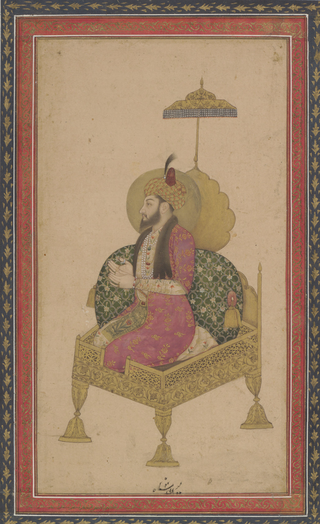
Mirza Jalal-ud-din Miran Shah Beg, commonly known as Miran Shah, was a son of the Central Asian conqueror Timur, founder of the Timurid Empire.
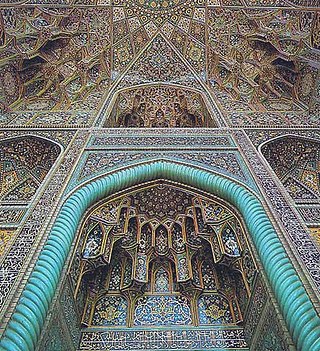
Gawhar Shad was the chief consort of Shah Rukh, the emperor of the Timurid Empire.

Iskandar Mirza was a member of the Timurid dynasty and the grandson of its founder, the Central Asian conqueror Timur. Iskandar was among the princes who attempted to claim the throne in the aftermath of Timur's death. He became a prominent ruler and was notable for his strong interest in culture and learning. He was defeated by his uncle Shah Rukh and later executed during a rebellion attempt.
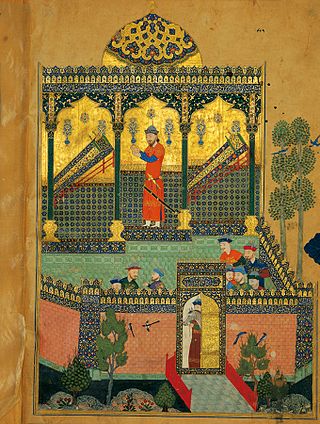
Ghiyath ud-din Baysunghur, commonly known as Baysonqor or Baysongor, Baysonghor or (incorrectly) as Baysunqar, also called Sultan Bāysonḡor Bahādor Khan (1397–1433) was a prince of the Timurid dynasty. He was known as a patron of arts and architecture, the leading patron of the Persian miniature in Iran, commissioning the Baysunghur Shahnameh and other works, as well as being a prominent calligrapher.

Abu Sa'id Mirza was the ruler of the Timurid Empire during the mid-fifteenth century.

The Musalla complex, also known as the Musallah Complex or the Musalla of Gawhar Shah, is a former Islamic religious complex located in Herat, Afghanistan, containing examples of Timurid architecture. Much of the 15th-century complex is in ruins today, and the buildings that still stand are in need of restoration. The complex ruins consist of the five Musallah Minarets of Herat, the Mir Ali Sher Navai mausoleum, the Gawhar Shad Mausoleum, and the ruins of a large mosque and a madrasa complex.

Mu'iz-ud-din Umar Shaikh Mirza was a member of the Timurid dynasty and a son of its founder, the Central Asian conqueror Timur. Known for being a skilled soldier, Umar Shaikh was one of Timur's military commanders and also served as a regional governor. He died in 1394, predeceasing his father by over a decade.
Ghiyas-ud-din Jahangir Mirza was a member of the Timurid dynasty and a son of its founder, the Central Asian conqueror Timur. He was Timur's favourite son and served as one of his military commanders as well as his heir apparent. However, Jahangir died in 1376, predeceasing his father by almost thirty years.
Sevin Beg Khanzada also known as Khanzada, was a princess of the Sufi dynasty, the ruling Turco-Mongol dynasty of Khwarezm, and daughter-in-law twice-over to the Central Asian conqueror Timur through her marriages to his sons Jahangir and Miran Shah. Through her maternal grandfather Jani Beg, she was a direct descendant of Genghis Khan.
Bayqara Mirza I was a Timurid prince and a grandson of the Central Asian conqueror Timur by his eldest son Umar Shaikh Mirza I.

Muhammad Sultan Mirza was a member of the Timurid dynasty and a grandson of its founder, the Central Asian conqueror Timur. As Timur's favourite grandson, Muhammad Sultan served as one of his principal military commanders, helping lead forces in successful campaigns against the Golden Horde, Persian kingdoms and the Ottoman Empire. Described by the historian Arabshah as "a manifest prodigy in his noble nature and vigour", Muhammad Sultan was eventually appointed by Timur as heir-apparent to the empire. His premature death in 1403 greatly affected his grandfather.
Rukn-ud-din Ala al-Dawla Mirza, also spelt Ala ud-Dawla and Ala ud-Daula, was a Timurid prince and a grandson of the Central Asian ruler Shah Rukh. Following his grandfather's death, Ala al-Dawla became embroiled in the ensuing succession struggle. Though he initially possessed a strategic advantage, he was eventually overtaken by his more successful rivals. Ala al-Dawla died in exile after numerous failed attempts to gain the throne.
Muhammad Juki Mirza was a Timurid prince and a son of the Central Asian ruler Shah Rukh. He served as one of his father's military commanders and may have been favoured as his preferred successor. However, he died of illness in 1445, predeceasing Shah Rukh by two years.
Pir Muhammad Mirza was a Timurid prince and a grandson of the Central Asian conqueror Timur by his eldest son Umar Shaikh Mirza I.
Rustam Mirza was a Timurid prince and a grandson of the Central Asian conqueror Timur by his eldest son Umar Shaikh Mirza I.
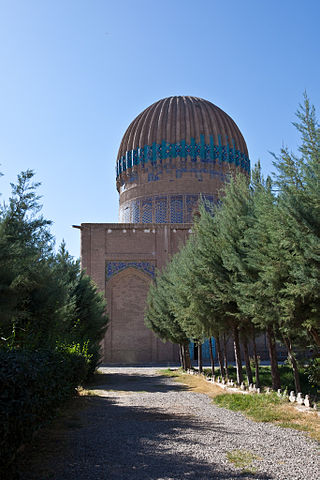
The Gawhar Shad Mausoleum, also known as the Tomb of Baysunghur, is an Islamic burial structure located in what is now Herat, Afghanistan. Built in the 15th century, the structure served as a royal tomb for members of the Timurid dynasty and is part of the Musalla Complex.
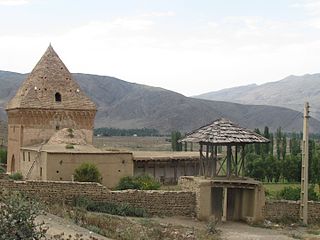
Kayumarth I was the ruler (ustandar) of the Baduspanids from 1394 to 1453, with a three-year interruption. An active expansionist ruler, his kingdom experienced a resurgence during his long reign, which included the reconquest of Rustamdar. He was often at odds with his suzerain, the Timurid ruler Shah Rukh. After his death, a dynastic struggle followed, which resulted in his kingdom being split up by his sons Iskandar IV and Ka'us II, in Kojur and Nur respectively.
References
- ↑ Woods (1990), pp. 18, 20.
- ↑ Balabanlilar (2015), p. 102.
- 1 2 Manz (2007), p. 29.
- 1 2 3 Nashat & Beck (2003), p. 128.
- ↑ Nashat & Beck (2003), pp. 125, 128.
- ↑ Arbabzadah (2017), p. 66.
- ↑ Bosworth & Asimov (2002), pp. 41–42.
- ↑ Rizvi (2011), p. 226.
- ↑ Glassen (1989).